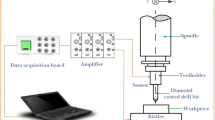Abstract
This paper aims to establish the wear mechanisms of coated and uncoated tungsten carbide drills when drilling carbon fibre reinforced plastics (CFRP)/aluminium alloy (Al) stacks. During the drilling experiments, thrust forces were measured. A scanning electron microscope (SEM) and a numerical microscope, provided with a scanning device, were periodically used to analyse tool wear mechanisms and to measure wear progression of the tool cutting edges. For both coated and uncoated drills, abrasion was the dominant tool wear mechanism, affecting the entire cutting edges. Higher wear was observed on uncoated tools which caused a significant increase in thrust force during drilling both Al and CFRP materials. The influence of these phenomena on the quality of the holes and on the generated roughness was also discussed.
Similar content being viewed by others
References
Batzer SA, Haan DM, Rao PD, Olson WW, Sutherland JW (1998) Chip morphology and hole surface texture in the drilling of cast aluminum alloys. J Mater Process Technol 79(1–3):72–78
Nouari M, List G, Girot F, Géhin D (2005) Effect of machining parameters and coating on wear mechanisms in dry drilling of aluminium alloys. Int J Mach Tool Manuf 45(12–13):1436–1442
Lachaud F, Piquet R, Collombet F, Surcin L (2001) Drilling of composite structures. Compos Struct 52(3–4):511–516
Hocheng H, Tsao CC (2003) Comprehensive analysis of delamination in drilling of composite materials with various drill bits. J Mater Process Technol 140(1–3):335–339
Iliescu D, Gehin D, Gutierrez ME, Girot F (2010) Modeling and tool wear in drilling of CFRP. Int J Mach Tool Manuf 50(2):204–213
Ramulu M, Branson T, Kim D (2001) A study on the drilling of composite and titanium stacks. Compos Struct 54(1):67–77
Park KH, Beal A, Kim D, Kwon P, Lantrip J (2011) Tool wear in drilling of composite/titanium stacks using carbide and polycrystalline diamond tools. Wear 271(11–12):2826–2835
Brinksmeier E, Janssen R (2002) Drilling of Multi-layer composite materials consisting of carbon fiber reinforced plastics (CFRP), titanium and aluminum alloys. CIRP Ann Manuf Technol 51(1):87–90
Zitoune R, Krishnaraj V, Collombet F (2010) Study of drilling of composite material and aluminium stack. Compos Struct 92(5):1246–1255
Rawat S, Attia H (2009) Characterization of the dry high speed drilling process of woven composites using Machinability Maps approach. CIRP Ann Manuf Technol 58(1):105–108
Rawat S, Attia H (2009) Wear mechanisms and tool life management of WC–Co drills during dry high speed drilling of woven carbon fibre composites. Wear 267(5–8):1022–1030
Zitoune R, Krishnaraj V, Almabouacif BS, Collombet F, Sima M, Jolin A (2012) Influence of machining parameters and new nano-coated tool on drilling performance of CFRP/Aluminium sandwich. Compos Part B: Eng 43(3):1480–1488
List G, Nouari M, Géhin D, Gomez S, Manaud JP, Le Petitcorps Y, Girot F (2005) Wear behaviour of cemented carbide tools in dry machining of aluminium alloy. Wear 259(7–12):1177–1189
Cheung FY, Zhou ZF, Geddam A, Li KY (2008) Cutting edge preparation using magnetic polishing and its influence on the performance of high-speed steel drills. J Mater Process Technol 208(1–3):196–204
Franke V (2011) Drilling of long fiber reinforced thermoplastics—influence of the cutting edge on the machining results. CIRP Ann Manuf Technol 60(1):65–68
Brinksmeier E, Fangmann S, Rentsch R (2011) Drilling of composites and resulting surface integrity. CIRP Ann Manuf Technol 60(1):57–60
Benezech L, Landon Y, Rubio W (2012) Study of manufacturing defects and tool geometry optimisation for multi-material stack drilling. Adv Mater Res 423:1–11
Shyha IS, Soo SL, Aspinwall DK, Bradley S, Perry R, Harden P, Dawson S (2011) Hole quality assessment following drilling of metallic-composite stacks. Int J Mach Tool Manuf 51(7–8):569–578
Ho-Cheng H, Dharan CKH (1990) Delamination during drilling in composite laminates. Trans ASME J Eng Ind 112:236–239
Iliescu D (2009) Approche expérimentale et numérique de l’usinage des composites carbone/epoxy. Thesis of the Ecole Nationale Supérieure des Arts et Métiers
Author information
Authors and Affiliations
Corresponding author
Rights and permissions
About this article
Cite this article
Montoya, M., Calamaz, M., Gehin, D. et al. Evaluation of the performance of coated and uncoated carbide tools in drilling thick CFRP/aluminium alloy stacks. Int J Adv Manuf Technol 68, 2111–2120 (2013). https://doi.org/10.1007/s00170-013-4817-0
Received:
Accepted:
Published:
Issue Date:
DOI: https://doi.org/10.1007/s00170-013-4817-0




